The Hidden Meanings of Your Favorite Flowers—and More About the Art of Floriography
Your bouquets may say more than you realize.
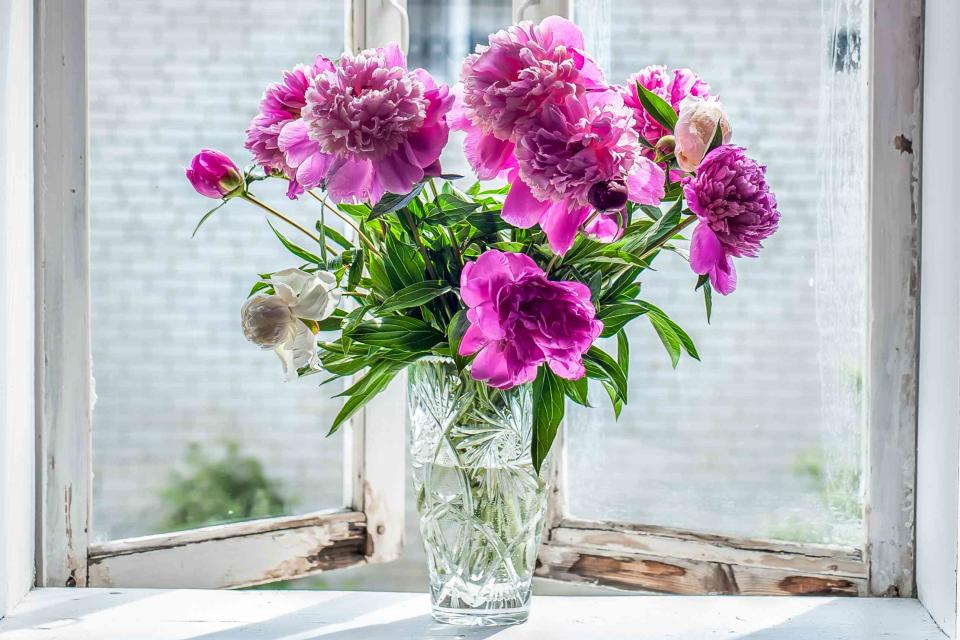
taratata / GETTY IMAGES
You may not be familiar with the history of floriography—the language of flowers—but if you’ve ever sent or received a bouquet, an arrangement, or even a single bloom, you’ve participated in this age-old tradition.
Experts Morgan Westerberg-Jackson, floriographer and head designer at Blomstra Floral Co., and Jessica Roux, author and illustrator of Floriography: An Illustrated Guide to the Victorian Language of Flowers, break down the tradition and the power of speaking through your favorite blooms—and share the hidden flower meanings of some of our favorite varieties.
Related: Plant These 10 Flowers in Your Garden for Good Luck
The History of Floriography
While floriography is most often associated with the Victorian era, its history goes back much further, says Westerberg-Jackson. “The Victorian era was really a revival for the language of flowers,” she says. “It actually has roots as far back as ancient Egypt, Greece, China, and many other places.”
During the 1800s, the exchange of flowers with specific meanings became an increasingly popular form of expression, as “proper etiquette discouraged open and flagrant displays of emotion,” says Roux. In 1819, author Charlotte de la Tour published Le Langage des Fleurs, which set down in writing meanings developed from mythology, religion, legend, and literature. (As florists stocked new inventory, they simply invented meanings to go along with their supply.)
“The Victorians were extremely romantic, and they compiled the meanings and used them as a method for communication when words either failed or were improper,” says Westerberg-Johnson. “You couldn't really say ‘Netflix and chill’ back then, but you could send some pea blossoms and white roses and it would mean, ‘I sincerely long for a tryst.’”
The Early Days of Flower Delivery
Just after the turn of the century, the Society of American Florists (SAF) launched Florists Telegraph Delivery (known today as FTD), making it even easier for young men and women to send bouquets “as tokens of love or warning,” writes Roux. As the floral industry slowed during World War I, the practice of floriography became less common, though the SAF’s famous slogan, “Say it with flowers,” still reinforces the power of floral communication.
Floriography's Relevance Today
“We don’t see flowers with their specific meanings that often today, but there are a few that have lasted the test of time,” says Roux. “The most obvious example is the use of roses to convey love: from gifts to a romantic interest, to at weddings and on Valentine’s Day, roses have secured their meaning through time. Autumn-blooming chrysanthemums are still used in funerals and at gravesites today, with their meaning of ‘condolences’ lasting through the ages.”
How Flowers Get Their Meanings
The practice of assigning meaning to flowers isn’t an exact science. “Many of the meanings the people of the time compiled to create this complex language were pulled from Greek, Norse, Chinese, and Celtic legends,” says Westerberg-Jackson. In some cases, a specific plant plays a role in the story—like mistletoe, which became associated with love and happiness after being used to kill the Norse god Balder. In others, the relationship is more abstract—like in the myth of Clytie, who spent so long pining for her lover, the sun god Helios, that she transformed into a heliotrope flower, which bends to follow the sun.
Not all flowers were associated with cheerful feelings, either, says Roux. “Death and mourning were also large parts of life as a Victorian, so there are a variety of flowers for somber occasions. For example, willows represent mourning, and we can see them depicted on Victorian mourning jewelry and gravestones,” she says.
Many plants have multiple meanings—some positive, some less so—and can pick up even more symbolism when arranged with other flowers. “Because of this, the language of flowers is fluid and flexible,” says Westerberg-Jackson. “It's possible to say pretty much anything with flowers. A bride could carry a bouquet full of wheat, white chrysanthemums, magnolias, and peach roses. What does it mean? 'I want to be with you, forever united. I give you all that I have—I promise I will always love you.'"
Finding New Meaning
With new flowers being cultivated all the time, modern floriographers consider the history of the bloom, the color, and the meanings of its cousins to inform the sentiments they assign to it. For Westerberg-Jackson, toffee roses, introduced in 2018, are a useful example. “The color doesn't have an ancient meaning,” she says. “However, using color symbolism, general rose symbolism, and the swirly look of the petals, we can form a meaning for this rose. Typically when I use this rose, it speaks of stability and groundedness. Alternatively, it can mean ‘unique beauty,’ the historical meaning historically for uniquely colored roses.”
The Secret Meanings of Your Favorite Flowers
Even those of us who aren't experts in floriography gravitate toward certain flowers and colors for specific occasions: Pure whites for brides, bright orange and pink to bring cheer, and reds for love. "Every botanical element has a message to share," says Westerberg-Jackson. "This is a double-edged sword at times, though, because this also means a certain bouquet could have a variety of meanings. It's best to look at the situation and determine what was meant."
Pink Roses: Healing
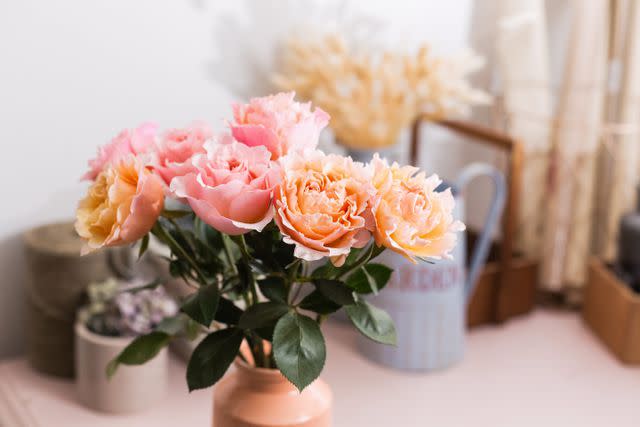
Malkovstock / GETTY IMAGES
Roses have held onto their meanings more than many other flowers, with red still tied to passion and romance, white for innocent love, and yellow for friendship. While pink can suggest a blossoming romance, it can also symbolize healing, says Roux.
"In Greek myth, Chloris, the goddess of flowers, is said to have turned a beautiful, dead nymph into a rose," says Roux. Then she allowed the gods to give it new life: "She invited Apollo to warm the bloom, Aphrodite to lend it her beauty, Dionysus to add sweet nectar, and the three Graces to supply charm, joy, and magnificence."
The connection between pink roses and healing may have a more practical tie, too. "Historically, roses have been connected with healing because they were used in many folk remedies," says Westerberg-Morgan. "One of the oldest headache remedies is steeping a cloth in cool rosewater and placing it on the temples. There are over 32 old remedies pertaining to everything from skin issues to nerve trouble—and many more ailments. Why pink specifically? Color psychology is huge and well-recognized. Pink brings grace, healing, and hope."
Sunflowers: Good Luck
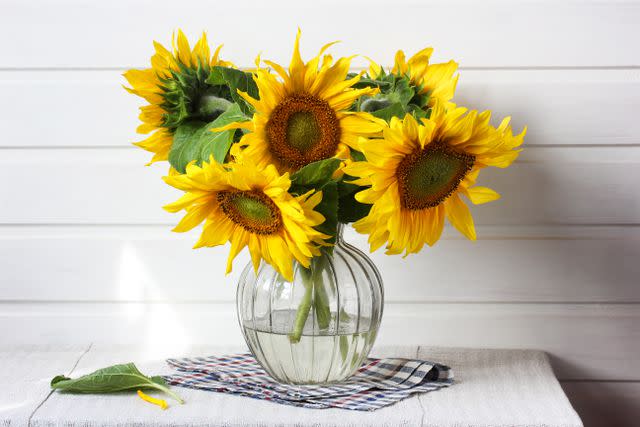
MaskaRad / GETTY IMAGES
Though sunflowers have multiple meanings—and are even tied to the same legend of Clytie and Helios as heliotrope—their happiest association is with good luck. “Sunflowers mean good luck because they follow the sun, which is an indispensable source of energy, clarity, and light,” says Westerberg-Jackson. “This vitality translates to these flowers, which stand in full bloom and have traditionally symbolized long life, vitality, and happiness—all things that are connected with good fortune.”
Peonies: Bravery
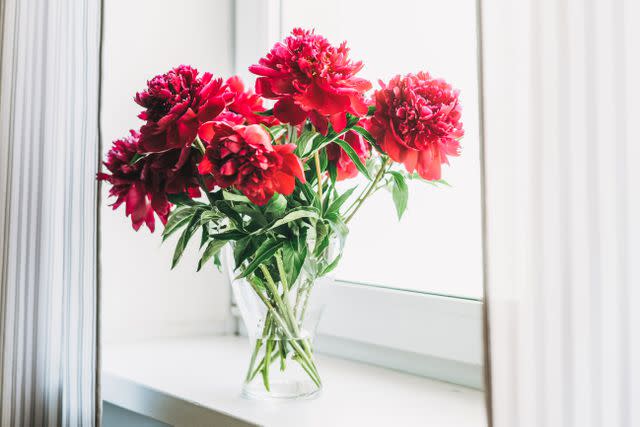
Galina Zhigalova / GETTY IMAGES
Fluffy peonies are part of traditional Japanese art; the bloom stars in a Japanese legend in which a samurai appears to a princess in the form of a peony, says Westerberg-Jackson. “Samurais are revered for their bravery and honor. The color red is traditionally connected with courage and passion, and I think in part that is how peonies came to have an association with bravery,” she says. “I think the peony is actually looked at as brave in and of itself. There are old superstitions, legends, and folk tales about the protective powers of peonies. It is meant to chase off evil, storms, and mischievous fairies.”
Orchids: Elegance
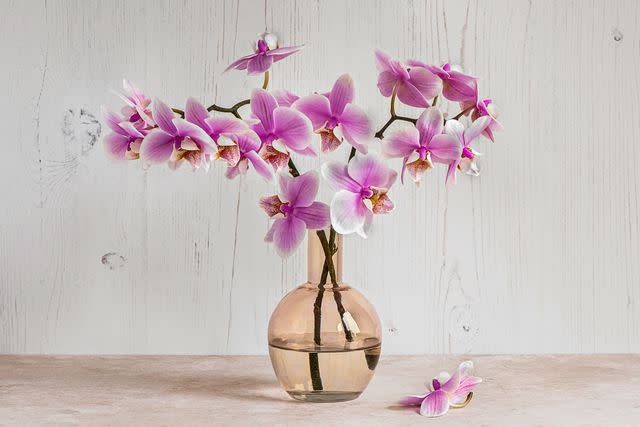
Jacky Parker Photography / GETTY IMAGES
Each type of orchid offers its own meaning, but phalaenopsis, one of the most popular types, represents elegance, wealth, and opulence—though not because of myth or legend, says Westerberg-Jackson. “Orchids during the Victorian era were only found in tropical climates. The majority of the speaking with floriography that was being done was in the U.K. and Americas—not so tropical. Typically, the people who were able to procure and bring back these flowers were wealthy, so orchids therefore became associated with luxury, wealth, and all the elegance that entails.”
Lilies: Purity
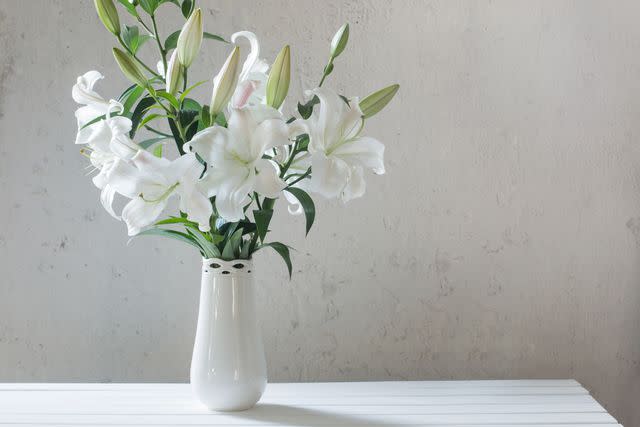
Getty Images
White lilies, also called Madonna lilies, have a religious association that represents purity. “In the Middle Ages, the lily became associated with the Virgin Mary,” says Roux. “Paintings of the Annunciation from this time often depict the archangel Gabriel giving the Blessed Mother a lily, honoring her purity.” (Other colors have different meanings: Orange represents passion, while yellow symbolizes happiness, says Westerberg-Jackson.)
Daisies: Optimism
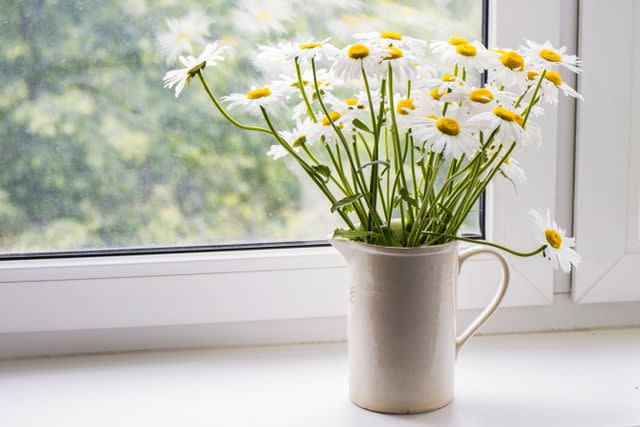
Nataliya Belova / GETTY IMAGES
Cheerful yellow-and-white daisies, often associated with the innocence and purity of childhood, also represent optimism, says Roux. “These are wonderful for cheering a person who is unwell or dealing with difficulties, as well,” says Westerberg-Jackson.
Lilacs: First Love
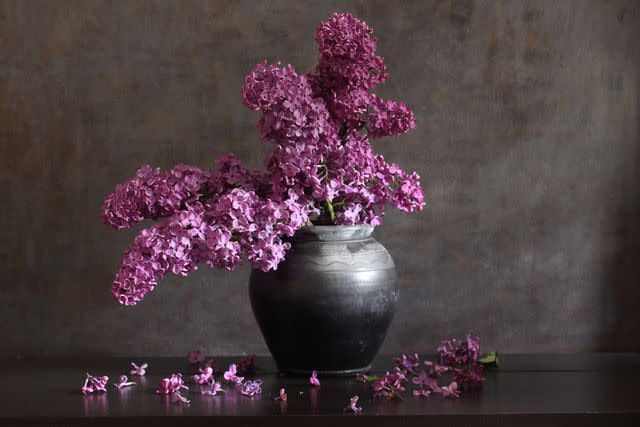
Getty Images
The origin of the connection between lilacs and first love comes from the Greek myth of Pan and Syringa, says Roux. “Pan, the god of the forests, was in love with Syringa, a nymph who feared his advances,” she says. “To disguise herself, she turned into a lilac bush. Pan, upon finding the shrub, cut its hollow reeds to form the first pan flute, memorializing his first love.”

